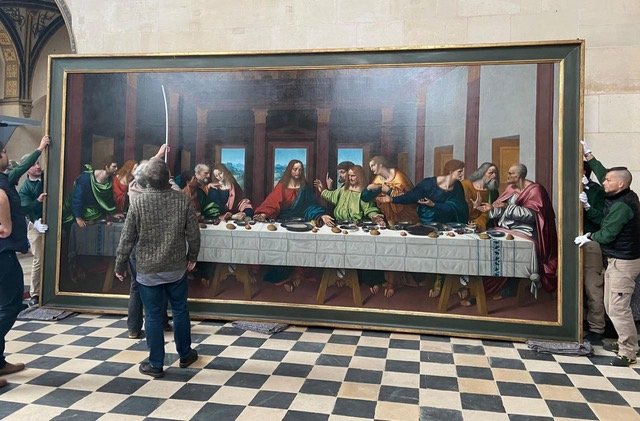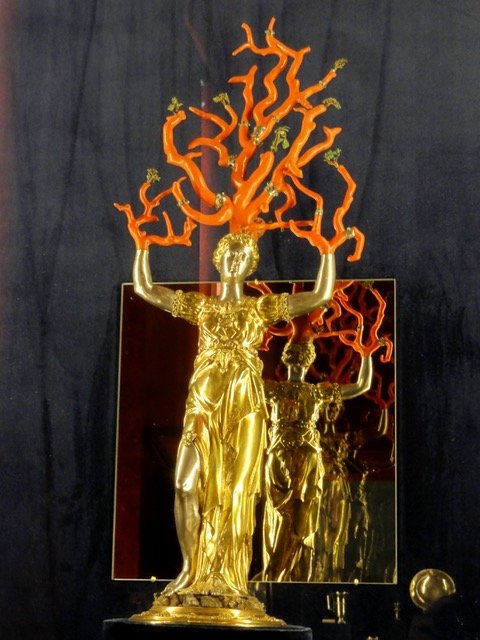Guaranteed to Enlarge your Paris: the Chateau d’Écouen
It was a dream come true, well at least my dream came true. I was invited to participate in a junket. Well, a bus trip. With other journalists. To the Chateau d’Ecouen. I had been there once before and I was looking forward to visiting this lovely chateau again. But even better than that. We were going to be met by the curators of the current temporary exhibition. On Venetian 16th century glass. Which is especially interesting to me since, perhaps I’ve mentioned this before, my son, the Eagle Scout and Muay Thai fighter, went to art school and graduated with a degree in glass art.
As I walked from the bus to the Chateau, I chatted with a young woman. And of course, we asked each other what publication we each wrote for, as one does. She told me that she writes for ‘Enlarge your Paris’. I thought she was joking. But turns out she was and she wasn’t. The name is both a joke and a reference to the publication’s focus. What to do around Paris. And that’s what I am going to do for you here, now. Extend, enlarge, make bigger, whatever, your Paris by telling you about this chateau that is not very far from Paris. (Figure 1)
Figure 1. Chateau d’Écouen
The Chateau d’Ecouen, aka the Musée National de la Renaissance is about 20 km north of Paris and accessible by train from the Gare du Nord. You can make the trip in less than an hour. Take a metro home and don’t get stuck in traffic like we did.
The Château was built (on the site of an existing fortress), between 1539 and 1555 for Anne de Montmorency (a man), the commander of the French army for Francois I and then for Henri II. It went through many iterations as it passed from one noble family to another and weathered the French Revolution and various Napoleons and monarchs.
Finally, in 1962, it was declared an historic monument. A few years later, Andre Malraux, Minister of Culture for Charles de Gaulle, proposed that the château become the home of the Renaissance art collection then housed at the Cluny Museum, the museum of medieval art. Which didn’t need it, didn’t want it. So, that’s what happened.
Here are three of my favorite objets in the permanent collection. A copy of Leonardo da Vinci’s Last Supper, (Figure 2) painted in Milan (where the fresco is, of course) before 1509 (so no more than 10 years after the original). By a pupil of Leonardo’s. It was one of the highlights of the Leonardo show at the Louvre a couple years ago. You know why? Because the Apostles in this painting all have feet. Which looks very weird for two reasons, the bottom of Leonardo’s fresco right below Christ was chopped off a long time ago. And of course, the fresco has faded, a lot. (Figure 3) Resulting in most of the apostles losing their feet. So, the only way to see how Leonardo intended his fresco to look, with all apostles in possession of their extremities, is copies like this one.
Figure 2. Copy of Leonardo’s Last Supper (before 1509) being returned to Écouen after Louvre exhibition
Figure 3. The Last Supper, Leonardo da Vinci, Milan, Italy, 1495-08
Another favorite of mine is a painting on wood, originally the lid of a cassone, a marriage chest. Cassoni were luxury items as well as practical pieces of furniture since they were filled with a bride’s clothes, linens, etc. The subjects depicted on the cassoni always impart a lesson to the bride. Usually about fidelity This one, painted by a Sienese artist in the 1470s, is no different. it is a scene from Homer’s Odyssey which depicts Odysseus’ wife Penelope weaving. (Figure 4) Because that’s what she did. She wove all day and ripped out her weaving all night. To avoid having to choose another husband. She waited 20 years for her roaming husband to finally come home. Surely a symbol of fidelity if ever there was one.
Figure 4. Casonne with Penelope Weaving, far left detail.
My third favorite piece, which is probably my most favorite piece actually, is a statuette of Daphne. (Figure 5) You know, Apollo and Daphne from Ovid’s Metamorphosis. Briefly, Daphne, a beautiful nymph was running through the woods. Apollo saw her and fell in love, well at least in lust. He started chasing her. Daphne knew what would happen if he caught her, so she shouted to her father, a river god as it happens, begging him to save her. And he did. He transformed Daphne, his daughter, into a laurel tree. Apollo did catch up with Daphne but her transformation had already begun. (Figure 6) So, in honor of the girl who got away, Apollo always wears a laurel wreath on his head.
Figure 5. Statuette of Daphne
Figure 6. Apollo and Daphne. Piero del Pollaiuolo, 1470
This statuette shows Daphne as the transformation is beginning, her fingers are turning into leaves and her head into sprouting branches. The statuette is made of gilded silver, with Daphne’s hands/head - leaves/branches - made of red coral. Did you know that red coral was used as a baby pacifier in the 18th century. There are tons (well maybe dozens) of portraits of babies holding or sucking their pacifiers, their baby corals.(Figure 7)
Figure 7. Early American Painting of babies with their baby corals
The temporary exhibition? Right. It will be on through Valentine’s Day, 2022. The exhibition is both a history of taste, specifically in Europe for glass objects made in Italy, particularly those objects made in Murano, Italy. The dissemination of those objects and the travels of the glassmakers who were trained to make those objects are traced here. (Figure 8) The exhibition is also a scientific investigation. Through chemical analysis of the glass, it was possible to distinguish between a real Venetian glass object and an object created in the Venetian style elsewhere. (Figure 9) Between a glass object from the 16th century and later forgeries and fakes, created to fool a buyer into thinking he was buying an original Murano glass object. A video created by the Corning Glass Studio explains the process of glass blowing. Warmed the heart of this glass blower’s mother! Enlarge your Paris, get out of town and check out the Chateau d’Ecouen. You’ll be glad you did!
Figure 8. Examples of Venetian Glass, Chateau d'Écouen
Figure 9. Examples of Venetian Glass, Chateau d'Écouen
Copyright © 2021 Beverly Held, Ph.D. All rights reserved
Dear Reader, I hope you enjoyed reading this article. Please click here or sign up below to receive more articles plus other original content from me, Dr. B. Merci!
And, if you enjoyed reading this review, please consider writing a comment. Thank you









